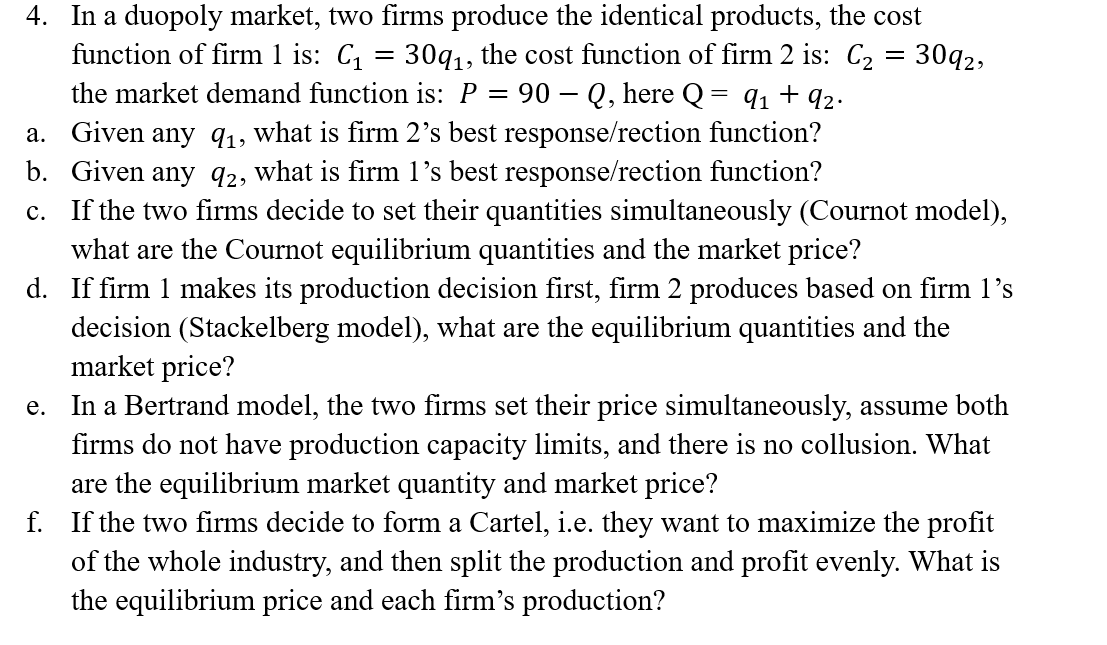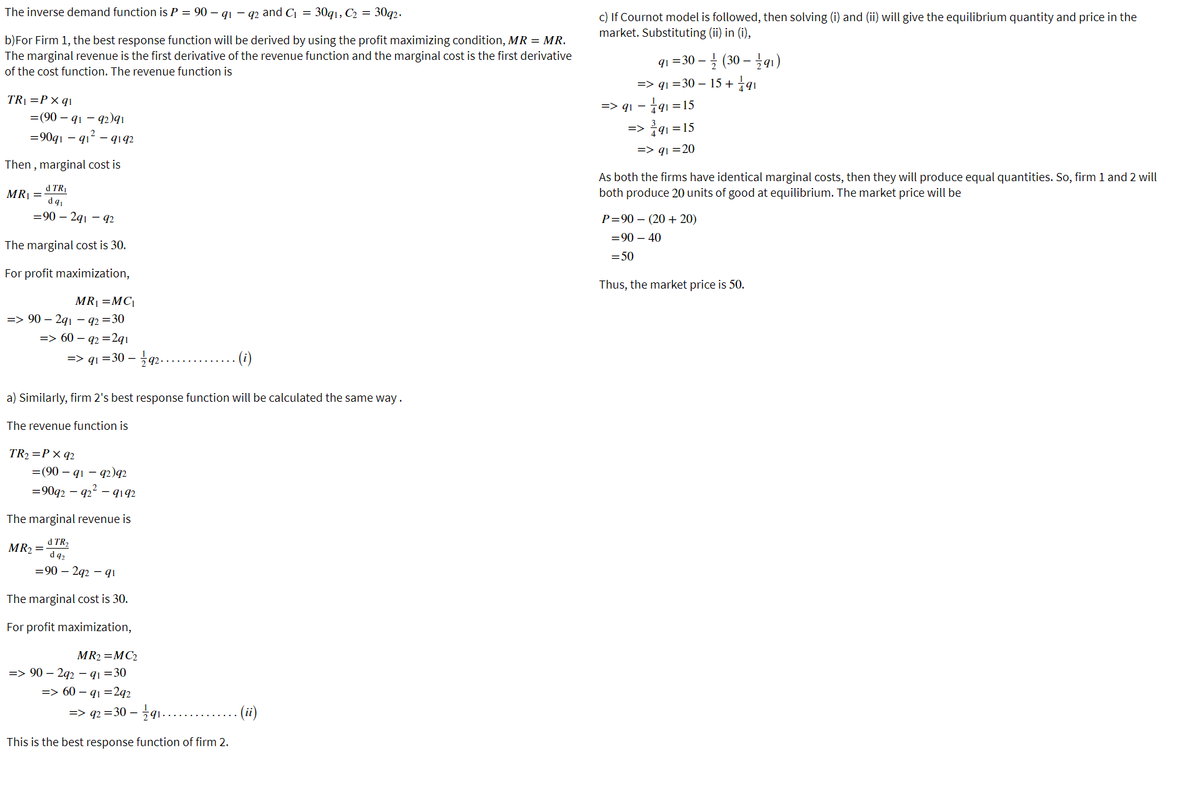In a duopoly market, two firms produce the identical products, the cost function of firm 1 is: C, = 30qı, the cost function of firm 2 is: C2 = 30q2, the market demand function is: P = 90 – Q, here Q = q1 + q2. Given any q1, what is firm 2's best response/rection function? Given any q2, what is firm 1's best response/rection function? If the two firms decide to set their quantities simultaneously (Cournot model), what are the Cournot equilibrium quantities and the market price? If firm 1 makes its production decision first, firm 2 produces based on firm 1's decision (Stackelberg model), what are the equilibrium quantities and the market price? In a Bertrand model, the two firms set their price simultaneously, assume both firms do not have production capacity limits, and there is no collusion. What are the equilibrium market quantity and market price? If the two firms decide to form a Cartel, i.e. they want to maximize the profit of the whole industry, and then split the production and profit evenly. What is the equilibrium price and each firm's production?
In a duopoly market, two firms produce the identical products, the cost function of firm 1 is: C, = 30qı, the cost function of firm 2 is: C2 = 30q2, the market demand function is: P = 90 – Q, here Q = q1 + q2. Given any q1, what is firm 2's best response/rection function? Given any q2, what is firm 1's best response/rection function? If the two firms decide to set their quantities simultaneously (Cournot model), what are the Cournot equilibrium quantities and the market price? If firm 1 makes its production decision first, firm 2 produces based on firm 1's decision (Stackelberg model), what are the equilibrium quantities and the market price? In a Bertrand model, the two firms set their price simultaneously, assume both firms do not have production capacity limits, and there is no collusion. What are the equilibrium market quantity and market price? If the two firms decide to form a Cartel, i.e. they want to maximize the profit of the whole industry, and then split the production and profit evenly. What is the equilibrium price and each firm's production?
Chapter15: Imperfect Competition
Section: Chapter Questions
Problem 15.4P
Related questions
Question
100%
I need solutions D,E, F
(I attached solutions of A.B.C)

Transcribed Image Text:4. In a duopoly market, two firms produce the identical products, the cost
function of firm 1 is: C = 30q1, the cost function of firm 2 is: C2 = 30q2,
the market demand function is: P = 90 – Q, here Q
a. Given any 91, what is firm 2's best response/rection function?
b. Given any q2, what is firm 1's best response/rection function?
c. If the two firms decide to set their quantities simultaneously (Cournot model),
what are the Cournot equilibrium quantities and the market price?
d. If firm 1 makes its production decision first, firm 2 produces based on firm l's
decision (Stackelberg model), what are the equilibrium quantities and the
market price?
In a Bertrand model, the two firms set their price simultaneously, assume both
firms do not have production capacity limits, and there is no collusion. What
are the equilibrium market quantity and market price?
f. If the two firms decide to form a Cartel, i.e. they want to maximize the profit
of the whole industry, and then split the production and profit evenly. What is
the equilibrium price and each firm's production?
91 + 92.
е.

Transcribed Image Text:The inverse demand function is P = 90 – qi – q2 and C, = 30q1, C2 = 30q2.
c) If Cournot model is followed, then solving (i) and (ii) will give the equilibrium quantity and price in the
market. Substituting (ii) in (i),
b)For Firm 1, the best response function will be derived by using the profit maximizing condition, MR = MR.
The marginal revenue is the first derivative of the revenue function and the marginal cost is the first derivative
of the cost function. The revenue function is
q1=30-1 (30-글 q1)
=> qı =30 – 15 + †q1
TRỊ =P× q1
=> q1 – 191 = 15
=(90 – q1 - q2)qı
3
=> 791 =15
=90q1 – q1 – qiq2
=> qı =20
Then, marginal cost is
d TRỊ
MR| =
As both the firms have identical marginal costs, then they will produce equal quantities. So, firm 1 and 2 will
both produce 20 units of good at equilibrium. The market price will be
=90 – 291 - 92
P=90 – (20 + 20)
=90 – 40
The marginal cost is 30.
= 50
For profit maximization,
Thus, the market price is 50.
MR1 =MC|
=> 90 – 291 – q2 =30
=> 60 – q2 =2qı
=> qı =30 – q2.....
- (i)
a) Similarly, firm 2's best response function will be calculated the same way.
The revenue function is
TR2 =P× q2
=(90 – q1 – q2)q2
=90q2 – 92 – 9192
The marginal revenue is
MR2 =
d TR2
d 92
=90 – 292 – qi
The marginal cost is 30.
For profit maximization,
MR2 =MC2
=> 90 – 292 – qq =30
=> 60 – q1 =2q2
%=> 42 = 30-글1
(ii)
This is the best response function of firm 2.
Expert Solution
This question has been solved!
Explore an expertly crafted, step-by-step solution for a thorough understanding of key concepts.
Step by step
Solved in 4 steps

Knowledge Booster
Learn more about
Need a deep-dive on the concept behind this application? Look no further. Learn more about this topic, economics and related others by exploring similar questions and additional content below.Recommended textbooks for you


Survey of Economics (MindTap Course List)
Economics
ISBN:
9781305260948
Author:
Irvin B. Tucker
Publisher:
Cengage Learning



Survey of Economics (MindTap Course List)
Economics
ISBN:
9781305260948
Author:
Irvin B. Tucker
Publisher:
Cengage Learning


Managerial Economics: Applications, Strategies an…
Economics
ISBN:
9781305506381
Author:
James R. McGuigan, R. Charles Moyer, Frederick H.deB. Harris
Publisher:
Cengage Learning

